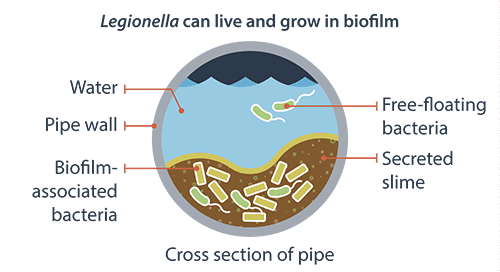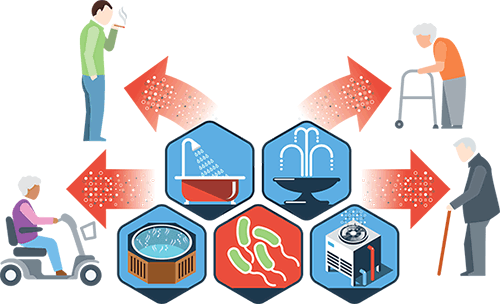What Owners and Managers of Buildings and Healthcare Facilities Need to Know about the Growth and Spread of Legionella
Legionella, the bacterium that causes Legionnaires’ disease, occurs naturally in freshwater environments, like lakes and streams. Generally the low amounts of these bacteria in freshwater do not lead to disease. However, Legionella can pose a health risk when it gets into building water systems. To do this, Legionella first has to grow (increase in numbers). Then it has to spread through small water droplets (aerosolization) that people can breathe in. You can take steps to reduce the risk for Legionella in your building.
Factors That Lead to Legionella Growth

A variety of internal and external factors can lead to a Legionella problem in your building, including
- Construction
- Water main breaks
- Changes in municipal water quality
- Biofilm
- Scale and sediment
- Water temperature fluctuations
- pH fluctuations
- Inadequate levels of disinfectant
- Changes in water pressure
- Water stagnation
How to Address Legionella Growth
Make Sure Disinfectant Amounts Are Right
When there is a reduction in disinfectant levels in your building water systems, Legionella can grow. In some buildings, processes such as heating, storing, and filtering can reduce the amount of available disinfectant, allowing Legionella to grow if steps are not taken to stop it. Your building water supply may need long-term supplemental disinfectants added to the water to boost the level of disinfectant and help limit Legionella growth. Examples of disinfectants include chlorine, mono-chloramine, chlorine dioxide, ultraviolet light, and ozone.
Make Sure Water Temperatures Are Right
Legionella grows best within a certain temperature range (77°F-113°F). To keep water outside the range for Legionella growth, it is important to keep cold water cold and keep hot water hot.
- A note about cold water: In warm climates, water in pipes that carry cold water may reach a temperature that allows Legionella to grow.
- A note about hot water: It is important to maintain water heaters at appropriate temperatures while following local and state anti-scald regulations. Sometimes maximum temperatures allowed by your state may be too low to limit Legionella growth. Engineering controls that mix hot and cold water together at or near the point of use can reduce the risk of scalding while allowing water in pipes to remain hot enough to limit Legionella growth.
Prevent Stagnation
When water does not flow well, the resulting areas of stagnation encourage biofilm growth, reduce water temperatures to levels that allow Legionella to grow, and reduce levels of disinfectant. It is important to understand the flow of water in your building in order to identify areas of risk where water may become stagnant.
Operate and Maintain Equipment
Maintaining and operating your building’s equipment effectively will help prevent biofilm, organic debris, and corrosion from contaminating your water system; all of these provide a habitat and nutrients for Legionella.
Monitor External Factors
It is important to monitor external factors that may affect the water entering a building and increase the growth of Legionella in complex water systems. Construction, water main breaks, and changes in municipal water quality are all important factors to consider.
Where Legionella Can Grow or Spread
Legionella can grow in many parts of building water systems that are continually wet, and certain devices can then spread contaminated water droplets. Some examples of devices where Legionella can grow and/or spread through aerosolization or aspiration (when water accidentally goes into the lungs while drinking) include:

- Hot and cold water storage tanks
- Water heaters
- Water hammer arrestors
- Expansion tanks
- Water filters
- Electronic and manual faucets
- Aerators
- Faucet flow restrictors
- Showerheads and hoses
- Pipes, valves, and fittings
- Centrally installed misters, atomizers, air washers, and humidifiers
- Nonstream aerosol-generating humidifiers
- Infrequently used equipment including eyewash stations
- Ice machines
- Hot tubs
- Decorative fountains
- Cooling towers
- Medical equipment (such as CPAP machines, hydrotherapy equipment, bronchoscopes)
People at Risk for Legionnaires’ Disease
People can get Legionnaires’ disease if they breathe in water droplets containing Legionella or if contaminated water goes into the lungs while drinking. Certain groups of people are at increased risk for getting Legionnaires’ disease, including those 50 years or older, current or former smokers, and people with chronic disease or weakened immune systems.
Learn more about Legionnaires’ disease pdf icon[1 page].
Waterborne Risks beyond Legionella
Many of the environmental factors that encourage Legionella growth also allow for growth of other are germs that grow well in drinking water distribution systems, such as Pseudomonas and nontuberculous mycobacteria. For healthcare facilities, water management programs are especially important as a way to help reduce the risk of infection among vulnerable patient populations, staff, and visitors.
Learn more from CDC’s toolkit: Developing a Water Management Program to Reduce Legionella Growth & Spread in Buildings.